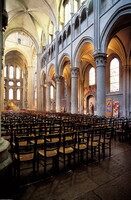| dc.coverage.spatial | Site: Dijon, Burgundy, France | en_US |
| dc.coverage.temporal | 1220-1250 (creation) | en_US |
| dc.creator | unknown (French) | en_US |
| dc.date | 1220-1250 | en_US |
| dc.date.accessioned | 2013-02-22T15:48:06Z | |
| dc.date.available | 2013-02-22T15:48:06Z | |
| dc.date.issued | 1220-1250 | en_US |
| dc.identifier | 194081 | en_US |
| dc.identifier.other | archrefid: 1425 | en_US |
| dc.identifier.uri | http://hdl.handle.net/1721.3/101415 | |
| dc.description | View into the south side aisle; The building dates from the first half of the thirteenth century. Viollet-le-Duc studied the structure of Notre-Dame de Dijon. The tall, monolithic and incredibly thin colonettes which support the apse vaults he describes as "splender pins, as strong as if they were of cast iron, thanks to the quality of the stone employed". In 1183-1187 Hugh III granted free status to the inhabitants. The Gothic parish church of Notre-Dame (1220-1250), with a deep narthex, a façade with superimposed galleries and a lantern-tower, became the centre of municipal life; the city clock was installed there in 1386 (Dijon had no town hall before 1500). Source: Grove Art Online; http://www.oxfordartonline.com/ (accessed 7/16/2008) | en_US |
| dc.format.medium | stained glass; stone | en_US |
| dc.rights | © Scott Gilchrist, Archivision, Inc. | en_US |
| dc.subject | architectural exteriors | en_US |
| dc.subject | Mary, Blessed Virgin, Saint | en_US |
| dc.subject | religious | en_US |
| dc.subject | Gothic (Medieval) | en_US |
| dc.title | Notre-Dame de Dijon | en_US |
| dc.title.alternative | Notre Dame, Dijon | en_US |
| dc.type | image | en_US |
| dc.rights.access | Licensed for educational and research use by the MIT community only | en_US |
| dc.identifier.vendorcode | 1A2-F-D-ND-C3 | en_US |
| vra.culturalContext | French | en_US |
| vra.technique | construction (assembling) stained glass | en_US |
| vra.worktype | church | en_US |
| vra.worktype | stained glass (visual work) | en_US |
| dc.contributor.display | unknown (French) | en_US |


